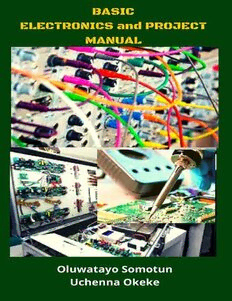Table Of ContentBASIC ELECTRONICS and PROJECT MANUAL
A step-by-step guide to start learning electronics
.
CONTAIN EXPERIMENTS THAT WILL OPEN UP YOUR MIND TO
TECH CREATIVITY AND INNOVATIONS SUCH AS; LIGHT
DISPLAY, FAN WITH CONTROL, TOY CAR MOTION CONTROL,
PHONE CHARGER, FLASHING LIGHT, SIMPLE AMPLIFIER,
LIGHT CONTROLLED SWITCH AND LOTS MORE
EDUSOD Logistics Service
…LEARN, APPLY AND DEVELOP
BASIC ELECTRONICS and PROJECT MANUAL
A step-by-step guide to start learning electronics.
By
Oluwatayo Somotun
Uchenna Okeke
Email: edusodservices@gmail.com
Basic Electronics and Project Manual
A step-by-step guide to start learning electronics.
By Oluwatayo Somotun and Uchenna Okeke
DISCLAIMER
While the author has used good faith efforts to ensure that the information
and instructions contained in this work are accurate, the author disclaim all
responsibility for errors or omissions, including without limitation
responsibility for damages resulting from the use of or reliance on this work.
Use of the information and instructions contained in this work is at your own
risk.
CREDITS
The CAD software for schematic and breadboard design is an open-source
initiative called Fritzing. For more information about this tool, please visit
https://fritzing.org.
Photo credit to the owners of original images and pictures used in this book
obtained from the internet.
SAFETY WARNING
This book is suitable for personal and instructional purposes
Not suitable for children under 4 years of age
Adult supervision is required for younger users
Always observe safety precautions at all times - “Safety First”
No part of this publication may be reproduced or distributed in any form or
by any means, or stored in a database or retrieval system, without the prior
written permission of the author, with the exception that the program
listings may be entered, stored, and executed in a computer system, but they
may not be reproduced for publication.
© 2018 By EDUSOD Logistics Services. All rights reserved.
For supports, training resources and other services from EDUSOD Logistics
Services, contact;
Tel: 08094244576, 07015813133
DEDICATION
This book is dedicated to the Most High God; the Father, the Son and the
Holy Ghost.
ACKNOWLEDGEMENT
I, Oluwatayo Somotun appreciate Uchenna Okeke and Tosin Oluwunmi for
their contribution and dedication in making these resources available through
the EDUSOD Logistics Services. We could not have had this opportunity
while growing up but we definitely believe that through our little
contributions, we could help someone on the path to fulfilling his/her dreams
in life.
My profound gratitude goes to Mr and Mrs P.O. Somotun, Mr.. and Mrs
Okeke, Mr. and Mrs. Oluwunmi, our siblings and relatives.
I also like to appreciate the immerse contributions of Mr. Femi Oluwaferanmi
in this work and for setting an example for us through the Reality Tech
Training Centre, Abeokuta.
To all those who have given brilliant ideas and objective insights for the
actualization of this work Pastor Festus Owara, Michael Oyegbola, Victor
Choji, Rasheed Sholanke, Tumininu Adeyiga, Michael Adedeji to mention
but a few, we say thank you all.
To the Rev. E. K Ajose and other past Priests and members of St. John’s
Anglican Church Aboru, I appreciate you all.
I will also like to appreciate all the staffs of the Department of Physics,
University of Lagos, who have made efforts in adding value to our lives.
Finally, to everyone who sees possibilities in life; everyone who is ready to
make trials and learn from mistakes until the goal is achieved; everyone who
will not despair; let us know that better days are ahead.
If we believe, with passion and focus, we can achieve the unimaginable!
THANK YOU.
TABLE OF CONTENT
Introduction......................................................................................viii
How To Use This book……………………………...............................ix
SECTION ONE: THEORY
PART 1………………………………………………………......................2
Chapter 1…………………………....………...……………......................3
1.0 The breadboard………………….………………………...................3
1.1 Sizes of breadboards…………………………………......................4
1.2 Other features of the breadboard……………………....................4
1.3 Wires, cables and connectors…………………………..................6
1.4 Common breadbord connection mistakes……………................7
1.5 Making permanent connection………………………….................7
Chapter 2………………..…………………………………........................8
2.0 The multimeter…………………………………………....................8
2.1 Types of multimeters……………………………………..................8
2.2 Parts of a multimeter……………………………………...................8
Chapter 3………………………………..………………………...............10
3.0 Cells and Batteries……………………………………….................10
3.1 How a battery works………………………………………..............11
3.2 Water analogy of the operation of a battery…………................11
3.3 Describing a battery………………………………………...............12
3.4 DC sources…………………………………………………...............12
3.5 Ways of producing dc……………………………………................13
3.6 Application of dc………………………………………….................13
3.7 AC sources………………………………………………...................14
3.8 Application of ac………………………………………….................14
3.9 Electricity, voltage, current, resistance and ohm’s law............15
3.9.1 Voltage…………………………………………...................17
3.9.2 Current…………………………………………...................17
3.9.3 Resistance……………………………………….................18
3.9.4 Ohm’s law………………………………………..................18
Chapter 4…………………………..…………………………...................20
4.0 Resistors…………………………………………………....................20
4.1 Resistor units ……………………………………………...................20
4.2 Resistor types and circuit symbols…………………….................21
4.3 Resistor categories………………………………………..................21
4.4 Understanding resistor color codes…………………...................22
4.4.1 Four-band colour code………………………...................22
4.5 Resistor power rating……………………………………..................24
4.6 Basic functions of resistors in a circuit……………….................24
4.7 Resistance, resistivity and conductance……………...................25
4.8 Electrical energy, power and current heating effect...................27
4.9 Power consumer and producers………………………..................28
4.9.1 How to calculate power………………………..................28
4.9.2 Power and ohm’s law relationship…………..................29
4.10 Heating element…………………………………………..................30
4.11 Understanding power rating…………………………...................30
Chapter 5 ………………...…………………………………………………31
5.0 Light Emitting Diode (LED) …………………………………………31
5.1 What are leds? ………………………………………………………..31
5.2 Filament bulb vs led…………………………………………………..31
5.3 Types of led…………………………………………………………….32
5.4 How an led works……………………………………………………..32
5.5 Led forward voltage and maximum current……………………...33
5.6 Understanding electric circuit and schematics………………….34
5.6.1 Short circuit………………………………………………….35
5.6.2 Open circuit………………………………………………….35
5.7 Understanding circuit schematics.……………...…………………36
5.8 Tips for proper circuit schematics or diagram drawing………..37
Chapter 6……………...……………………………………………………..39
6.0 Fuses……………………………………………………………………..39
6.1 How a fuse works………………………………………………………39
6.2 Types of fuse……………………………………………………………40
6.3 Safety handling tips……………………………………………………41
PART 2………………………………………………………………………..42
Chapter 7…..………………………………………………………………...43
7.0 Series and Parallel……………………………………………………..43
7.1 Series arrangement……………………………………………………43
7.2 Parallel arrangement…………………………………………………..44
7.3 Calculating total resistance in series arrangement……………...45
7.4 Calculating total resistance in parallel arrangement…………….46
7.5 Combining series and parallel connections……………………....47
7.6 Cells in series and parallel arrangement………………………….47
Chapter 8……..………………………………………………………………49
8.0 Variable resistors and voltage divider……………………………..49

